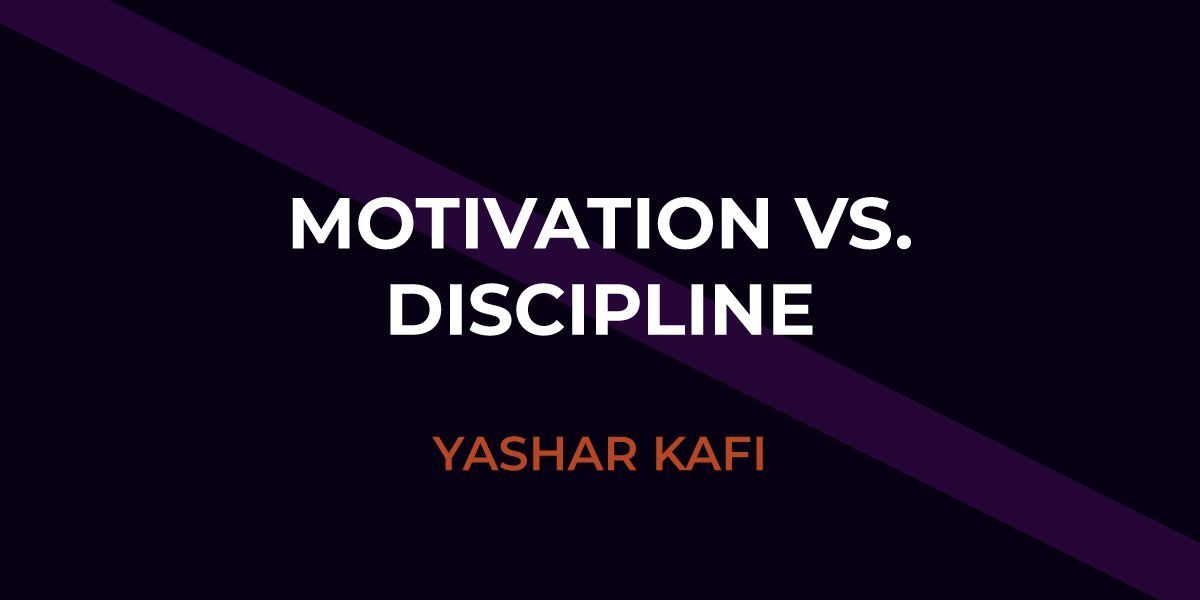Motivation vs. Discipline
Here’s something that the education system should teach our children as they grow up, and also something that many young adults today don’t quite understand: motivation versus discipline. Motivation and discipline are two words that I hear regularly, yet they almost always seem to be misused. I say “misused” because I’ve noticed that people say them interchangeably as if their meanings are the same. I’d like to let you know that they are not the same, nor should they be used as if they are.
The Definitions
Alright, so let’s clear up what the two words actually mean.
Here are the definitions:
Motivation:
- (n) The general desire or willingness of someone to do something.
Discipline:
- (v) To train by instruction and exercise; drill.
Motivation is a noun. It’s a thing that exists. Whereas, discipline also has a verb form—i.e., a doing/action word. Discipline is something that you choose to do; motivation is just there, and it can come and go as it pleases. You have no control over motivation, and you cannot be motivated to be disciplined.
Bringing Them Together
Our primal motivation worked well in humanity’s infancy, when life was a “do or die” scenario, with survival being our only aim. You had to make fire, you had to find food, you had to find water, and you had to find shelter. These weren’t optional, and so, people were motivated to get on with the task at hand. But in the modern world, it’s a little different because the aim of the game has changed—the standard of living has changed, and the meaning of “survival” has too.
Many people lack motivation altogether. This is where discipline comes into play. You can look at it as the power that shapes your actions, feelings, and thoughts, driving you to adopt new behaviors when your motivation has given up and told you to do otherwise.
I should add that discipline is useless if a person hasn’t tied it to the actions that they want to be disciplined with. In other words, it’s pretty much irrelevant unless it is being used.
Now, I quite often see on résumés or hear in workplaces that somebody is “disciplined.” People use this as a personality trait, without realizing that it’s a pretty weak one. That may sound harsh, but I look at it this way: even the most routine people at work are missing something; you can’t always be disciplined in everything that you have to do unless you’re superhuman and can juggle and perform all of your tasks perfectly. If you could do that, we wouldn’t employ teams at work now, would we?
When you’re planning on changing something at work:
- Allow motivation to inspire you, drive your innovative thoughts, and light the flame of change within you. Do not expect it to hang about, though.
- Once your motivation has sparked this new way of thinking, you need to focus on building more disciplined actions around it. So, for example, if you’ve decided you want to speed up team briefings and think of an excellent way to do it, you need to become disciplined enough to implement the innovation. The term “get on with it” comes to mind.
- Finally, you need to be specific with what the discipline will look like when it comes to achieving your particular goal. It’s much easier to stick to a well-established plan, rather than a mish-mash of half-thought-through ideas that are liable to change.
When discussing the motivation versus discipline topic, often people ask me:
“Which is more important?”
The truth of the matter is motivation, and discipline, or self-discipline, work hand-in-hand. They are equally important when it comes to forming the habits that you need to establish for success at work or in life—Ying and Yang, if you like. They work in harmony if implemented correctly; you can use motivation for the initial boost and startup process, while self-discipline will allow you to sustain the effort, keeping you focused on the task at hand.




